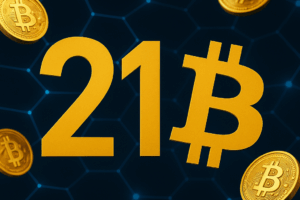Cryptocurrencies are still considered a kind of gambling by many inexperienced people. This is undoubtedly due to the fact that the media mainly focus on the high susceptibility to fluctuations – the so-called volatility – when it comes to Bitcoin and altcoins. And indeed, the past few weeks have repeatedly demonstrated how quickly prices can rise and, unfortunately, fall on the market. But it is equally true that digital currencies are gaining increasing acceptance in the “mainstream”. And this makes coins and tokens more stable in value than in the early years of the industry. And there are analytical approaches that enable a Bitcoin price analysis. The stock-to-flow ratio is one such tool with which some investors have already had good Bitcoin experiences. A good reason to take a closer look at the term and the analysis background.
The most important data in a compact overview:
- Stock-to-flow ratio on the crypto market a young analysis method
- Analysis approach draws parallels to the precious metal gold
- Forecasts are based on the ratio of production volume market stock
- partly too uncertain data situation for the analysis
The “Ratio” Has Often Predicted Six-Figure BTC Prices
In a nutshell, the stock-to-flow ratio allows conclusions to be drawn about the scarcity of a good. This formulation, of course, requires a more detailed explanation in order to get an impression of the technical background and the informative value of the findings. In the past, the stock-to-flow ratio has brought many amazing predictions in the context of Bitcoin price analysis. In November 2019, for example, various reports circulated that saw the BTC price in regions of 250,000 US dollars and more for the spring of 2020. However, such forecasts often had statistical shortcomings. In addition, some estimates of astronomically high prices were mostly based on further assumptions, which are only of limited suitability for determining the actual stock-to-flow ratio.
Stock-to-flow: Ratio of Produced Quantity and Market Reserves as a Basis
This illustrates once again why clean analytical work is so important. Because even the third halving in the Bitcoin blockchain did not cause the price to rise as high as expected. But now let’s get to the actual explanation of the analysis option for the BTC price. The stock-to-flow ratio is about describing the scarcity of an asset – analog or digital. The term ratio here means “ratio”, “flow” stands for a possible production quantity, while “stock” defines the current inventory. The ratio means how much time elapses until the current inventory would be reached if the current production quantity is maintained. The relation between the stock and the produced quantity results in the scarcity of a good XY. The value of the scarcity increases in parallel with the level of the ratio.
The SF model is one of the young variants for price forecasting in BTC analysis. In its now common version, it has only recently been circulating in Bitcoin forums and on specialist portals. The originator of the concept is “PlanB”, a well-known crypto analyst. The same determined for the year 2019 that the currency pair of Bitcoin and US dollar only temporarily deviated from the stock-to-flow model. Especially towards the end of the year, however, there was a clearer fluctuation.
Restriction of Resources as an Important Criterion
None other than Nick Szabo sees in the aforementioned scarcity a “rather forgery-proof preciousness”. There are by definition a maximum of 21 million Bitcoins, which clearly distinguishes the digital currency from fiat currencies. In financial and economic crises, central banks like to turn on the money presses and increase the money supply, which is usually accompanied by an increase in inflation rates. Such developments, by the way, also leave a lasting impression on the crypto market, so that problems or economic events also have an influence on the Bitcoin price.
Analysis Model is Mainly Used for Gold
Actually, analysts base the stock-to-flow ratio primarily on raw materials such as the “safe haven for investors” gold. The basic assumption of a rising price with increasing scarcity is usually also true for precious metals. The application of the analysis instrument is generally also possible with regard to the Bitcoin price, but the resulting price forecasts lead to the aforementioned “moon prices”. Even the influence of the halvings that take place approximately every four years and the associated halving of the mining rewards is sometimes overestimated. A temporarily lower supply of coins in the system also has a disproportionately large impact on expectations in the stock-to-flow ratio.
High SF Value Speaks for Increasing Price Potential
Many industrial raw materials (e.g.) copper have always shown that the price is more or less significantly influenced by the adjustment of the quantities produced. Transferred to Bitcoin, scarcity can therefore be an important price indicator. This is about the ratio between stock and flow or the relationship between the amount of BTC available on the market and the tradable amount.
A calculation example: According to evaluations, a good 657,000 new Bitcoins were created in 2019 by means of mining. At the end of April 2020, the market had a contingent of approximately 18.36 million Bitcoins. In the simple calculation model, the stock-to-flow ratio is 27.9.
Due to the constant creation of new blocks and further halvings taking place, the relation of the stock to the new production is constantly increasing. Interestingly, various evaluations come to the conclusion that the stock-to-flow data of Bitcoin can certainly keep up with those of gold and silver. At the end of 2017, for example, the SF values of the BTC almost corresponded to the value of silver.
Critical Factors Must not be Disregarded
With regard to halvings, there is also a problem here. Experts like to talk about the halving of BTC rewards around a price corridor, which they call “Narrow Halving Window”. Around a halving, the price is usually moving in a price range that is not 100 percent confirmed later. As a statement about the past, however, the assumption of renewed increases is always the proverbial thin ice on which analysts meet. Especially since after the third halving, not only positive developments were apparent. The historically strong movement after earlier halvings is no guarantee for comparable trends in the future.
Caution with Overly Rosy Price Promises from Analysts
From the point of view of many analysts, the Bitcoin price forecast based on the S-2-F ratio is too speculative, others swear by the approach. The problem from the point of view of the critics is that the price movement is not determined solely by the Bitcoin production rate. An example: Current evaluations would lead to a probable price of 1.0 million US dollars after the fifth halving. Among other things, the market capitalization is too short in the stock-to-flow ratio. Some well-known analysts have calculated that for a million price, the BTC would have to reach a capitalization in an order of magnitude like relevant fiat currencies such as the US dollar or the euro. Despite increasing acceptance in trade, such developments are probably rather unlikely within a few years. The fact that Bitcoin is often referred to as “digital gold” must not be misunderstood in this context for another reason.
Demand Development Can be Influenced by many Points
Supporters of the stock-to-flow ratio must automatically assume that the coins are actually used. Whether this then happens as a means of payment, store of value or otherwise would be secondary. However, reliable predictions about an increasing – indispensable for the stock-to-flow ratio – demand can only be derived to a limited extent. There have been moments in Bitcoin history in which demand has surprisingly decreased. Further aspects that make analyses more difficult overall are unpredictability. New products such as futures and options on Bitcoin promoted greater acceptance some time ago. The interest of institutional investors also sends positive signals. The still difficult regulatory situation has a negative effect on the potentially increasing demand. Regular reports about alleged manipulations are in turn not exactly conducive to reliable forecasts via analysis instruments such as the stock-to-flow ratio.
Stock-to-flow Ratio Can Reveal Informative Value
Despite the difficulties that lurk on the way to price analysis for Bitcoin, the ratio can certainly be effective. After all, as the first digital asset, Bitcoin is per se designed for scarcity and is therefore on a par with precious metals such as gold and silver. Various analysts confirm that there is an actual relation between stock-to-flow on the one hand and the BTC market price on the other, which is often to be classified as “statistically relevant”. And this relationship is by no means based on pure chance. Ultimately, the evaluations of the analysis approach fluctuate between “justified” and “too vague”. The truth is: The tool must prove itself anew as a model calculation after every decisive market event. But this also applies to most other analysis paths for a still extremely volatile asset like Bitcoin.
Would you like to buy Bitcoin? The CoinPro.ch guide helps



